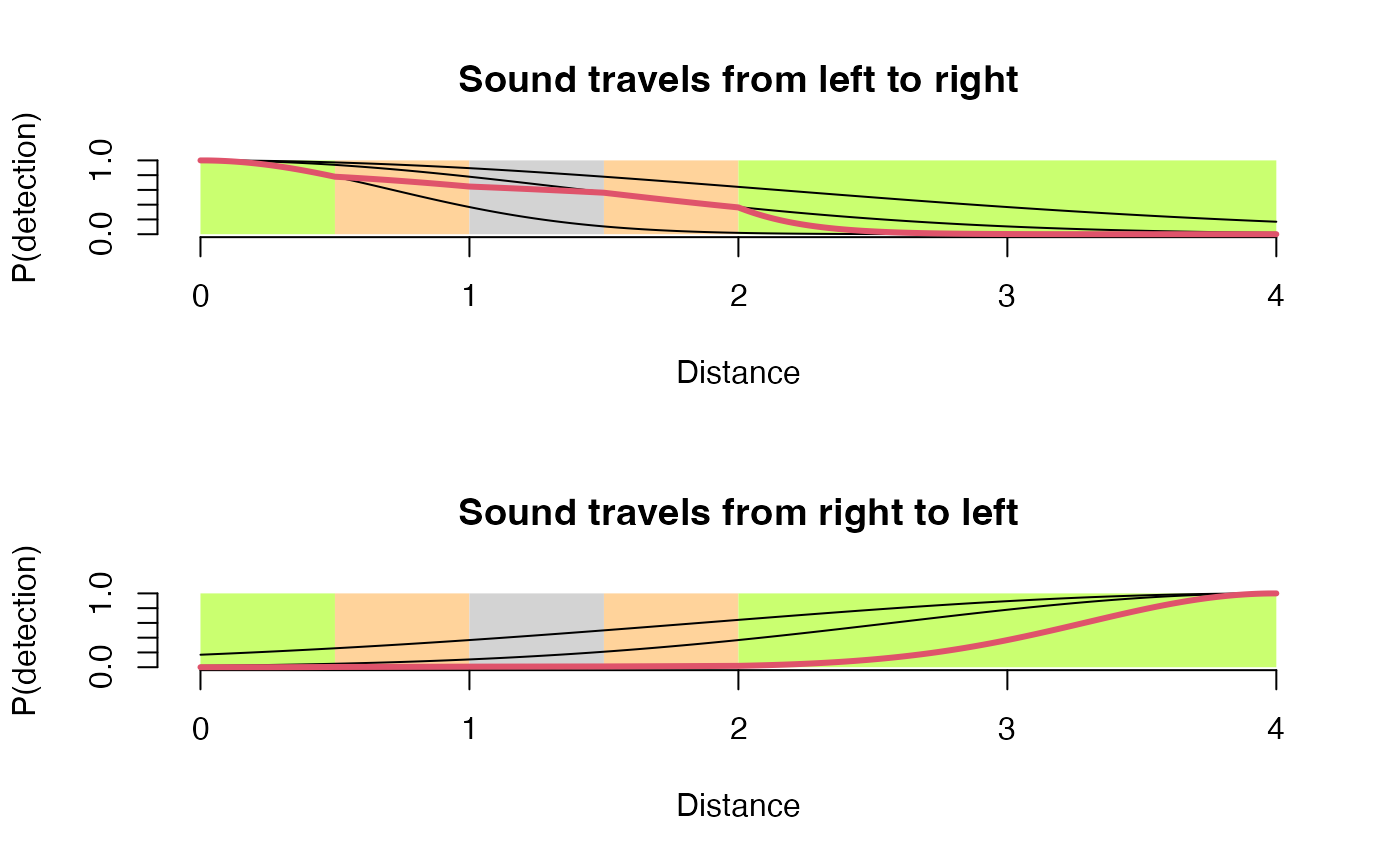Distance function with segmented attenuation
dist_fun2.RdDistance function with segmented attenuation crossing a number of boundaries of strata with different attenuation characteristics following results in Yip et al. (2017).
Usage
dist_fun2(d, tau, dist_fun, breaks = numeric(0), ...)Arguments
- d
distance from observer.
- tau
a parameter passed to the the distance function. Length of
taumust equallength(b) + 1referring to distance function parameters in the different strata (a stratum is defined by an interval surrounded by 1 or 2 boundaries).- dist_fun
distance function taking two arguments: distance, and
tau, see examples.- breaks
distance breakpoints, must be
length(tau) - 1in length. These breakpoints represent the boundaries between the intervals characterized by homogeneous attenuation characteristics.- ...
other arguments passed to
dist_fun
Value
Probability of detection given the distance, stratum specific parameters and the arrangement of breakpoints.
References
Yip, D. A., Bayne, E. M., Solymos, P., Campbell, J., and Proppe, J. D., 2017. Sound attenuation in forested and roadside environments: implications for avian point count surveys. Condor, 119: 73–84. <doi:10.1650/CONDOR-16-93.1>
Examples
tau <- c(1, 2, 3, 2, 1)
d <- seq(0, 4, 0.01)
dist_fun <- function(d, tau) exp(-(d/tau)^2) # half normal
#dist_fun <- function(d, tau) exp(-d/tau) # exponential
#dist_fun <- function(d, tau) 1-exp(-(d/tau)^-2) # hazard rate
b <- c(0.5, 1, 1.5, 2) # boundaries
op <- par(mfrow=c(2, 1))
plot(d, dist_fun2(d, tau[1], dist_fun), type="n",
ylab="P(detection)", xlab="Distance", axes=FALSE,
main="Sound travels from left to right")
axis(1)
axis(2)
for (i in seq_len(length(b)+1)) {
x1 <- c(0, b, 4)[i]
x2 <- c(0, b, 4)[i+1]
polygon(c(0, b, 4)[c(i, i, i+1, i+1)], c(0, 1, 1, 0),
border=NA,
col=c("darkolivegreen1", "burlywood1", "lightgrey",
"burlywood1", "darkolivegreen1")[i])
}
lines(d, dist_fun2(d, tau[1], dist_fun))
lines(d, dist_fun2(d, tau[2], dist_fun))
lines(d, dist_fun2(d, tau[3], dist_fun))
lines(d, dist_fun2(d, tau, dist_fun, b), col=2, lwd=3)
plot(rev(d), dist_fun2(d, tau[1], dist_fun), type="n",
ylab="P(detection)", xlab="Distance", axes=FALSE,
main="Sound travels from right to left")
axis(1)
axis(2)
for (i in seq_len(length(b)+1)) {
x1 <- c(0, b, 4)[i]
x2 <- c(0, b, 4)[i+1]
polygon(c(0, b, 4)[c(i, i, i+1, i+1)], c(0, 1, 1, 0),
border=NA,
col=c("darkolivegreen1", "burlywood1", "lightgrey",
"burlywood1", "darkolivegreen1")[i])
}
lines(rev(d), dist_fun2(d, tau[1], dist_fun))
lines(rev(d), dist_fun2(d, tau[2], dist_fun))
lines(rev(d), dist_fun2(d, tau[3], dist_fun))
lines(rev(d), dist_fun2(d, tau, dist_fun, rev(4-b)), col=2, lwd=3)
 par(op)
par(op)